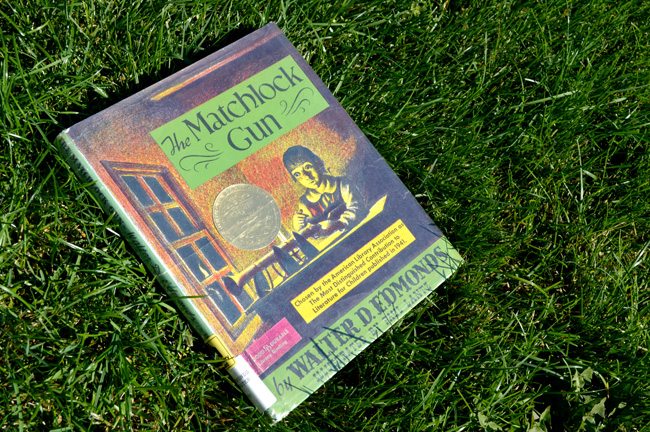Walter Edmond’s, The Matchlock Gun is the 1942 Newbery winner. This little tale is the story of Edward Van Alstyne, a ten year old boy of Dutch and German descent living in upstate New York about the time of the American Revolution who helps his mother protect his home and sister against warring local Native Americans while his father is away.
What I liked. I liked the gun—which is probably why they named the story after it—it’s kind of the best part. It more like a small Spanish canon than a gun. It’s been in Edward’s family for generations, but even his father has never shot it. But Edward gets to shoot it and save the day.
What was interesting. I thought the Dutch and German immigrants and heritage in the book was so fascinating. I happen to have just helped Evan create some lesson plans on New Netherlands (Manhattan and New Jersey) so it was fun to see a work of historical fiction that took that up.
What were some limitations. I didn’t love that the central theme is a 10 year old boy protecting his pretty young mother from the Indians. I mean evidently it really happened, so I suppose there is that to consider. Also, to give the author Edmonds’ slightly more credit, the mother is pretty resourceful herself—she’s really the one protecting her children. But something about the way that it’s written from Edward’s perspective that he keeps thinking about how beautiful and young his mother is and how he has to save her seems a bit too much for me.
Why I think it’s a Newbery. Matchlock Gun did have great prose, and the topic of the heroic boy saving the day was something that perhaps boys in the middle of WWII would have really resonated with.
Similarity to other Newbery winners. It is definitely in the running for the shortest Newbery; only The Cat Who Went to Heaven is similar in length. And again, we have another World War II era book that is about courageous young boys (or men) battling wild savages, just like the Daniel Boone and Call it Courage.
What it teaches me as a writer. The mother character (Gertrude Van Alstyne) was the most surprising part of the book. It reminded me of the power of strong mothers, and also the surprise of having a mother play the heroine. (I think one of my very favorite parts of Divergent was having Tris’ mother be so much more than she seems when we first meet her.) It’s good reminder because children’s fantasy tends to have rather passive (or totally absent) parental figures. And for good reason: if the parents are at all responsible they usually stop their children from doing whatever it is that gets them into the magical adventure in the first place. But that a really strong mother figure is such an asset makes the book stronger, because so many of us know that our own mothers really are strong and insightful, and a big part of our own stories.
Have you read Matchlock Gun? What are your favorite literary mother figures?
*Note* This post contains Amazon affiliate links, which means if you were to buy a book, I’d get a tiny commission at no cost to you. Thanks for supporting Stories & Thyme!*








I am glad you are numbering the Newberry reviews and I am very impressed that you have kept going through 21 of them so far. I like your critiques and the inclusion of some of the illustrations. Those give me a good feel for the book. I am surprised how many I haven’t read, so thank you for educating me about them.
Grandma
Thanks Grandma Anne! I’ve gotten a little bogged down these past few weeks! I’m actually in the middle of a great Newbery, my first re-read, ADAM OF THE ROAD. But I also started a number of non-Newbery’s and those are stilling my time. I am really going to miss Hays Thanksgiving this year! Love to you and Grandpa Jim!